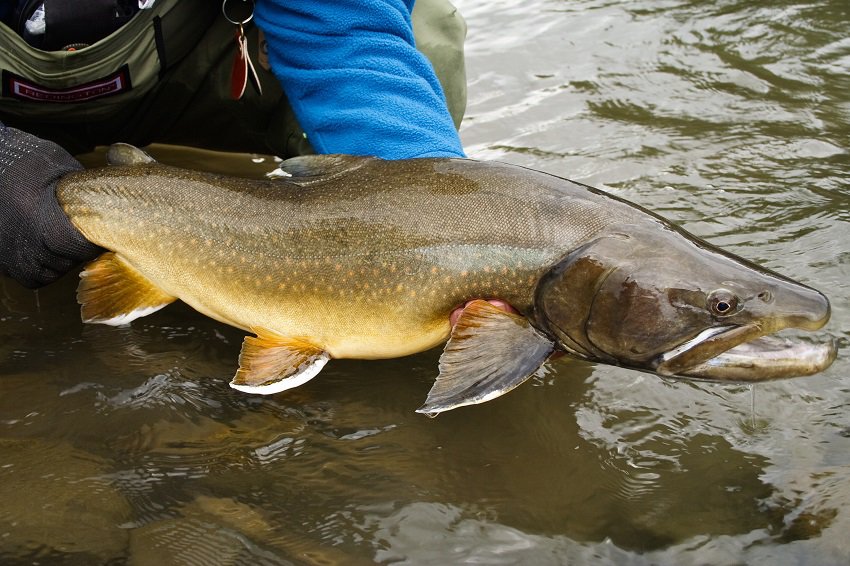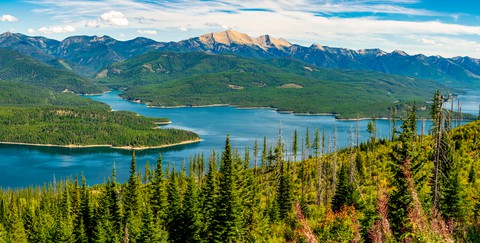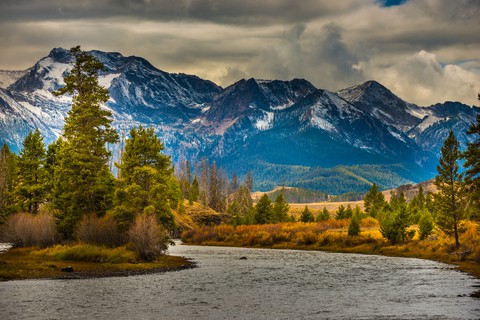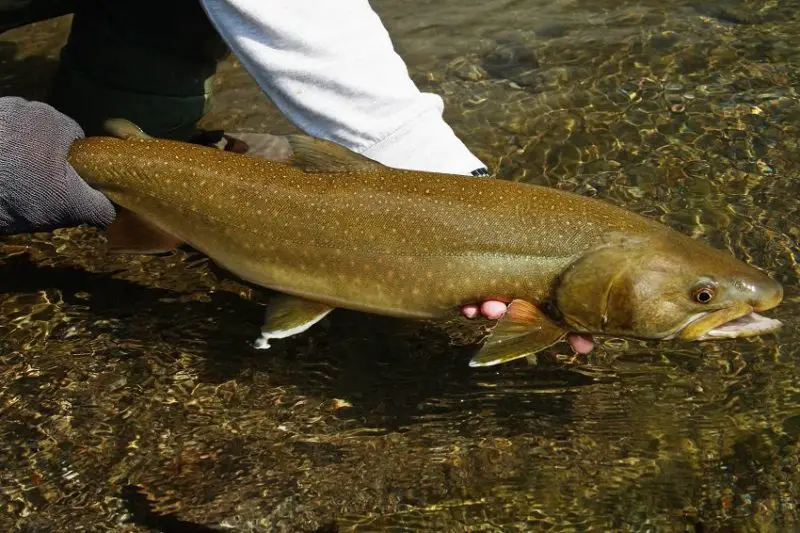We don’t have any Bull Trout in the area I live in. I’ve always conjured up in my mind’s eye visions of fishing trips that I haven’t taken yet to places like Montana, northern Idaho, or Oregon when Bull Trout are mentioned.
Bull trout live in some of the last best places on earth. As untouched wilderness disappears, so do the fish.
The following article will tell you all about Bull Trout in the Continental United States, how to identify them, what states you can find them in, and what laws govern fishing for them.
Vital Characteristics
Bull trout actually aren’t Trout at all. They’re members of the Char Family. Trout have dark spots over a lighter background. Char, on the other hand, have light-colored spots over a darker background. Char also don’t have any teeth on the roof of their mouths. Juvenile Bull Trout get mistaken for another member of the Char family, the Brook Trout sometimes.
Brook Trout, though, have dark spots on their dorsal fins, while bull trout do not. Adult Bull Trout are marked quite differently from the youngsters. They’re sometimes mistaken for yet another member of the Char family, the Lake Trout.
A tell-tale difference between Lake Trout and Bull Trout is that Lake Trout Have deeply forked tails while bull Trout do not. Adult Bull Trout have olive green-colored bodies fading to white on the belly, with pale orange spots along their sides. They have an unspotted dorsal fin. Like all char, they have a lite orange to white stripe on their pelvic and pectoral fins’ leading edge.
Bull trout have the genetic potential to get pretty darn big! Specimens have been recorded that were over 40″ inches long. The world record Bull weighed in at 32 pounds and was caught out of Lake Pend Oreille in northern Idaho. A percentage of these fish migrate through networks of rivers, lakes, and streams in the Northwest, while others will spend their entire lives in the same area. The migratory ones tend to be bigger.

Threatened Species
Bull trout are classified as a threatened species by the U.S. Endangered Species Act. Fishing for them is tightly regulated. For Example, I only found four waters in Montana where it is legal to intentionally fish for them and only one where it’s legal to harvest a fish. The yearly harvest limit there, by the way, is two per angler.
Where Bull Trout Hang Out
Bull Trout is found in the cold, clear waters of lakes, rivers, and streams in the Yukon, British Columbia, Alberta, western Montana, Washington, Oregon, Idaho, and the Jarbidge River in northern Nevada.
Habitat
Bull Trout Do Best In unspoiled wilderness Settings
These fish are pretty fussy about their habitat. They prefer deep pools, gravel bars, and log jams to hide beneath. They also need crystal-clear water at temperatures lower than 55 degrees Fahrenheit. Thus, they are a fish you’ll often find in the unspoiled backcountry of the northwest. They are truly the proverbial canary in the coal mine in terms of water quality. When water quality declines, these fish begin to disappear.
Different Life Histories
Bull trout may be anadromous in coastal rivers, or in other words, live in the ocean and come up in coastal rivers to spawn. Further inland, as stated earlier, they may migrate through inner connected river systems.
A segment of the Bull Trout population migrates long distances from lakes or the ocean through inflowing rivers to small tributary streams to spawn. Others spend their entire lives in the same general area.
However, the universal truth is that they require clean, relatively silt-free gravel beds to spawn in.
Females bury their eggs around six inches deep in gravel beds in nests known as “reds.” Studies have shown that when a stream bottom has more than 40% fine sediment, less than a quarter of bull trout eggs will survive the fry stage. The reason being that sediment clogs pores in the gravel bed, preventing oxygen from circulating down to the eggs.

Threats to Bull Trout Survivability
Sediments entering streams from any human-centered activity threaten the viability of Bull Trout populations. Natural seasonal water turbidity can also deposit silt in gravel beds otherwise used for spawning.
Dams in certain areas have blocked migration routes to spawning areas. Even poorly placed culverts impede fish migration.
Competition from introduced species has contributed to the decline of Bull Trout populations. All species introduced into the Bull trout habitat compete for available food. The closely related Lake Trout will feed on juvenile Bull Trout.
Brook trout is known to crossbreed with Bull Trout. The resulting offspring are sterile. A year’s production of the spawning Bull Trout has not gone towards the species’ proliferation when this takes place. Any serious attempt at implementing the Bull trout recovery must include a reduction of non-native fish species.
When large Bull trout enter small tributaries to spawn, they are especially visible and vulnerable to poaching. In the past, people have used large lures to snag spawning Bull Trout. Using pitchforks or spears to impale them is also not unheard of. This sort of intentional poaching isn’t as common as it once was.
A more common problem is unintentional harvest due to mistaken identity. This happens when an angler misidentifies a Bull Trout to be a different species. For example, juvenile Bull Trout look a lot like Brook Trout. A Bull trout has no spots on its dorsal fin, while a Brook Trout does. A fisherman that doesn’t know this could easily illegally harvest a Bull trout without realizing what they’re doing.
Another example is this. Adult Bull Trout look very similar to Lake Trout. Anglers sometimes mistake one for the other. Lake Trout, though, have a more deeply forked tail than do Bull trout.
States are working to educate anglers to quickly determine if they’ve landed a Bull trout. In most areas, these fish must be immediately released.
Bull Trout Fishing in Montana
I copied the following from the Montana 2020 Fishing Regulations Guide.
“2020 BULL TROUT REGULATIONS Bull trout fishing is permitted in four western district waters of Montana: Hungry Horse Reservoir, South Fork Flathead River, Lake Koocanusa, and Swan Lake. All other waters in Montana are closed to intentional fishing for bull trout. These four fisheries are very restrictive because bull trout are listed as a threatened species under the Endangered Species Act. See pages 2 and 3 for water-specific regulations. It is hoped that this permitted angling will increase public support for the management of stable bull trout populations, restoration of bull trout habitat, and for other management activities that will increase the distribution and abundance of bull trout populations throughout the state.”

Of the Montana waters open to intentional Bull Trout fishing, Hungry Horse Reservoir is the only place where an angler can take and keep a Bull Trout. The other three are catch-and-release only. At Hungry Horse Reservoir, a Fisherman may only take one Bull Trout per day and only have one in their possession. Additionally, the yearly limit for these fish is two per person. The following is additional information copied from the 2020 Montana Fish Wildlife and Parks Fishing Regulations guide.
Montana Bull Trout Additional Information
“BULL TROUT CATCH CARD A FWP bull trout PERMIT on your fishing license and a separate catch card is required and must be in possession while intentionally fishing for bull trout in the mainstem South Fork Flathead River upstream from Hungry Horse Reservoir, Hungry Horse Reservoir, and Lake Koocanusa. A catch card is not required for bull trout fishing on Swan Lake. Catch Cards will provide FWP with critical management information. Whether you fish for or harvest bull trout or not, your Catch Card should be kept until you have been surveyed by FWP and should be returned in the mail with your survey. Bull trout Catch Cards are available through the FWP Region 1 office free of charge. Applications are available online at fwp.mt.gov for no charge. You can help us better manage these fisheries by keeping accurate records while fishing for bull trout. Your catch card may not be transferred, borrowed, altered, or loaned to another person. Duplicate cards will not be issued, so take good care of your bull trout catch card. Immediately upon harvesting a bull trout, or if releasing a bull trout, you must record the following information with a ballpoint pen on your catch card: • Month and day of harvest. • Zone (A, B, C, D, E or F as indicated on waterbody maps.) • Length of bull trout to the nearest ½” (estimated length for fish caught-and-released) • Cut out one notch for each bull trout harvested from Hungry Horse Reservoir. NOTE: Anglers are not allowed to harvest two bull trout on the same day” Source
Even if you never hook into one of the spectacular fish, pursuing them in spectacular “Big Sky Country” is a reward in and of itself.

Bull Trout Fishing in Idaho
Catch And Release
Fishing specifically for Bull Trout in any Idaho water is legal on a catch-and-release basis only.
When bull trout were listed as threatened under the federal Endangered Species Act in 1998, the U.S. Fish and Wildlife Service determined state fishing regulations provided sufficient conservation benefits. In Idaho, bull trout fishing was allowed, but the harvest was not.
Those regulations are still in place to fish for and catch bull trout, but they must be immediately released unharmed. While they’re not as abundant as other trout types, Idaho’s bull trout populations are generally in good shape and capable of supporting great catch-and-release fishing opportunities.
Bull Trout fishing is exciting even though you can’t take them home. They’re large fish and aggressive by nature, and they can be caught on flies, lures, and bait if the body of water is open to bait fishing”.
Snake and Columbia River Drainages
You can find Idaho Bull Trout in most river drainages that feed into the Snake and Columbia rivers. They’re difficult to specifically target because of their migratory nature. However, an angler who knows their seasonal patterns can shift the odds of success in their favor by targeting them as they move into smaller high-country streams.
The world record Bull Trout was caught in 1942 in Lake Pend Oreille in Northern Idaho. The current Idaho record catch and release record, Bull Trout, was caught in the Salmon River and was 23.5 inches long.
Bull Trout in Nevada
The Jarbidge River Drainage in Northern Nevada is the Bull Trout’s Southernmost enclave. Any Bull Trout caught in Nevada must immediately be released.
Bull Trout in Washington State
What information I could find leads me to conclude that any Bull Trout caught in Washington State must immediately be released. Source
Bull Trout in California
Bull Trout once inhabited around sixty miles of the McCloud River, from its mouth to its lower Falls. That is no longer the case. Bull Trout are now extinct in California.
Bull Trout in Oregon
Lake Billy Chinook
Oregon’s Lake Billy Chinook is one of the few places in the Continental United States where you can still legally catch and keep Bull Trout. There is a daily bag limit of one fish over 24” long.
Metolius River
The Metolius is one of the three rivers that feed into Lake Billy Chinook. For the skilled angler, the Bull trout fishing here as at times, superb. Fish are at times migrating from the reservoir through the river and back again to either spawn or follow the spawning Chinook Salmon so they can gorge themselves on the eggs. For this reason, the Bull trout population here fluctuates.
Fishing for all trout species in the Metolius River is catch and release only.
There is no stocking of fish in the Metolius. Every fish is wild-born. These fish have become educated to a fisherman’s tricks and require a skilled angler to match wits with them. Someone with the skill, though, has an opportunity to catch giant bull trout as well as Rainbow trout, Brown Trout, Brook Trout, Kokanee Salmon, and Whitefish in some of the most beautiful scenery on earth. The Metolius is also one of the largest spring creeks in the United States.
Bull Trout Are Native To The Above States
There are also transplanted populations around the western US. There is also Bull Trout in British Columbia, Alberta, Yukon, and Northwest Territories of Canada. I’ll talk about them in a different article.
Recent Posts
The only venomous snakes in Washington State are Northern Pacific Rattlesnakes. The Northern Pacific Rattlesnake (Crotalus oreganus oreganus) is a sub-species of the Western Rattlesnake. Anyone...
Skunks are not classified as true hibernators. But they go into a state of torpor when the weather gets cold. Skunks are light sleep hibernators, along with opossums, bears, and raccoons. ...

